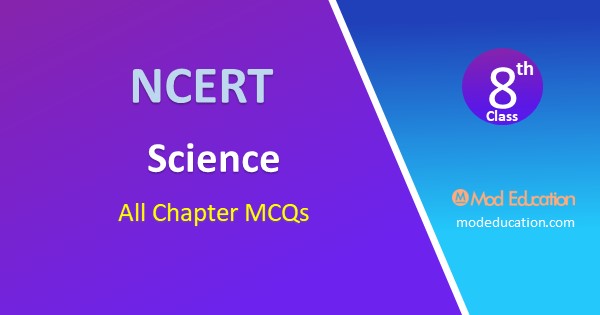MCQ Questions for Class 8 Science Chapter 16 : NCERT CBSE RBSE other Board MCQ Questions for Class 8 Science Chapter 16 Light with Answers Pdf free download. MCQ Questions for Class 8 Science with Answers were prepared based on the latest exam pattern.

MCQ Questions for Class 8 Science Chapter 16 Light with Answers
Q1. A smooth shining surface, which rebounds the light back in same or in different direction, is called
(a) a mirror
(b) a lens
(c) reflection of light
(d) point of incidence
Answer: (a) a mirror
Q2. The impression or sensation remains on the retina for about how may seconds even after removal of the object ?
(a) 1 second
(b) 1/16th of a second
(c) 16 seconds
(d) 1 minute
Answer: (b) 1/16th of a second
Q3. Beam of light striking the reflecting surface is called
(a) reflecting ray
(b) incident ray
(c) refracted ray
(d) normal ray
Answer: (b) incident ray
Q4. The cells present in the retina of eye and responding to intensity of light are:
(a) Rod-shaped cells
(b) Both of these
(c) Cones
(d) None of these
Answer: (a) Rod-shaped cells
Q5. Band of seven colours is called
(a) VIBGYOR
(b) spectrum
(c) dispersion
(d) reflection
Answer: (b) spectrum
Q6. The cells present in the retina of eye and responding to colour are:
(a) Rod-shaped cells
(b) Both of these
(c) Cones
(d) None of these
Answer: (c) Cones
Q7. Front balged part of the eyeball is called
(a) cornea
(b) choroid
(c) pupil
(d) retina
Answer: (a) cornea
Q8. The disease of eye in which crystalline lens becomes hazy or even opaque due to development of membrane over it is :
(a) Myopia
(b) Cataract
(c) Hypermetropia
(d) Presbyopia
Answer: (b) Cataract
Q9. Which one of the following statements is correct regarding rods and cones in the human eye?
(a) Cones are sensitive to dim light
(b) Cones are sensitive to bright light
(c) Rods are sensitive to bright light
(d) Rods can sense colour
Answer: (b) Cones are sensitive to bright light
Q10. Angle of incidence is equal to the angle of reflection:
(a) Always
(b) Sometimes
(c) Under special conditions
(d) Never
Answer: (a) Always
Q11. In case of reflection of light, the angle of incidence (i) and the angle of reflection (r) are related as
(a) i = r
(b) i < r (c) i > r
(d) no definite relation
Answer: (a) i = r
Question 13.
The amount of light entering the eye is controlled by
(a) eye lens
(b) cornea
(c) iris
(d) ciliary muscle
Answer: (c) iris
Question 14.
Myopia can be corrected by using a
(a) concave lens
(b) convex lens
(c) opaque lens
(d) micro lens
Answer: (a) concave lens
Question 15.
Light enters the eye through
(a) eye lens
(b) pupil
(c) cornea
(d) retina
Answer: (c) cornea
Question 16.
If the angle of incidence of light falling on a plane mirror is 30°, what will be the angle of reflection?
(a) 90°
(b) 60°
(c) 30°
(d) 0°
Answer: (c) 30 degree
Question 17.
When we stand in front of our dressing table, our left hand seems to be right and right seems to be left. This is called
(a) Left-right confusion
(b) Lateral inversion
(c) Up -side down phenomenon
(d) mirage
Answer: (b) Lateral inversion
Question 18.
Light passing through a prism splits into seven colours. This is called
(a) Dispersion
(b) Dissolution
(c) Division
(d) None of the above
Answer: (a) Dispersion
Question 19.
Rainbow is a natural phenomenon showing
(a) Reflection
(b) Deflection
(c) Dispersion
(d) Diversion
Answer: (a) Reflection
Question 20.
In the retina of the eye, the area having no sensory cells is called
(a) iris
(b) Blind spot
(c) cornea
(d) Dark spot
Answer: (b) Blind spot
Question 21.
If light falls perpendicularly on a plane mirror, what will be the angle in which it will be reflected?
(a) 45°
(b) 90°
(c) 180°
(d) 360°
Answer: (c) 180 degrees
Question 22.
Which of the following is not a luminous object?
(a) sun
(b) candle
(c) moon
(d) Tube light
Answer: (c) moon
Question 23.
To make a kaleidoscope we require
(a) Three plane mirrors
(b) Four plane mirrors
(c) Three glass sheets
(d) Four glass sheets
Answer: (a) Three plane mirrors
Question 24.
In our eye _______ cells can sense colour
(a) Rod
(b) Cone
(c) Both rod and cone
(d) Neither rod nor cone
Answer: (b) Cone
Question 25.
An owl can see clearly at night but not day time because it has
(a) More rods and few cones
(b) Less rod and more cones
(c) More rods and more cone
(d) Less rods and less cones
Answer: (a) More rods and few cones
Match the following items given in Column A with that in Column ‘B’:
| Column A | Column B |
| (i) Cornea | (a) Transparent front part of eye |
| (ii) Pupil | (b) Layer on which impression of images is formed |
| (iii) Iris | (c) Point on retina where there are no nerve endings |
| (iv) Retina | (d) Sensitive for bright light |
| (v) Blind spot | (e) Is a small opening in the cornea |
| (vi) Rods | (f) Sensitive for dim light |
| (vii) Cones | (g) Controls the size of the pupil |
Answer:
| Column A | Column B |
| (i) Cornea | (a) Transparent front part of eye |
| (ii) Pupil | (e) Is a small opening in the cornea |
| (iii) Iris | (g) Controls the size of the pupil |
| (iv) Retina | (b) Layer on which impression of images is formed |
| (v) Blind spot | (c) Point on retina where there are no nerve endings |
| (vi) Rods | (f) Sensitive for dim light |
| (vii) Cones | (d) Sensitive for bright light |
